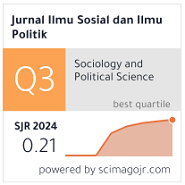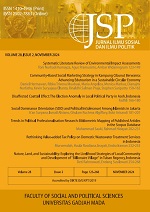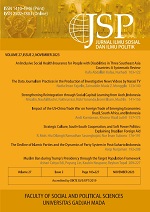Reclaiming an Anti-Tin Mining Territory: The Effectiveness of Formal Political Channels in East Belitung
Eko Bagus Sholihin(1*)
(1) Universitas Islam Negeri Raden Fatah Palembang, Indonesia
(*) Corresponding Author
Abstract
Tin, a mineral abundant beneath the coastal waters of Bangka Belitung, has spurred large-scale mining expansion from land to the sea. This article investigates the phenomenon of “reclaiming an anti-mining territory” as a representation of the Belitung community’s resistance against tin mining expansion into the coastal sea of East Belitung. The article is the result of deep fieldwork conducted during 2017-2020, employing methods such as participant observation and in-depth interviews with PT Timah, district and provincial government, local academics, resistance groups, local CSOs, fishermen, maritime tourist entrepreneurs, and traditional miners. This study reveals the limitations of the common argument that often raises scepticism about the accommodation and effectiveness of formal political channels for civil society resistance during conflicts over the expansion of extractive industries. Through a case study of the successful community resistance in East Belitung against the expansion of coastal tin mining, this article demonstrates that under certain preconditions—specifically, when “anti-sea mining” becomes a popular electoral issue— two specific key conditions can enable formal political channels to be effective: the recentralisation of mining authority and the formation of alliances with political elites. The findings further illustrate that zoning regulations, which were established in response to grassroots aspirations, were adhered to by all stakeholders, including licensed mining companies. These findings also present an opportunity for sustainable natural resource governance reform, particularly in terms of civic engagement in natural resources management.
Keywords
Full Text:
PDFReferences
Afrizal, & Berenschot, W. (2022). Land-Use Change Conflicts and Anti-Corporate Activism in Indonesia: A Review Essay. Journal of East Asian Studies, 22(2), 333–356. https://doi.org/10.1017/jea.2022.12
Ambari, M. (2019, July 5). Peraturan Zonasi Pesisir Hadir untuk Pinggirkan Masyarakat Pesisir. Mongabay. https://www.mongabay.co.id/2019/07/05/peraturan-zonasi-pesisir-hadir-untuk-pinggirkan-masyarakat-pesisir/
Aprionis. (2018, October 12). Potensi Timah Laut Belitung Timur Rp 100 Triliun. Antara News Babel. https://babel.antaranews.com/berita/86856/potensi-timah-laut-belitung-timur-rp100-triliun
Ardianto, H. T. (2016). Mitos Tambang untuk Kesejahteraan: Pertarungan Wacana Kesejahteraan dalam Kebijakan Pertambangan. Polgov.
Avcı, D., & Fernández-Salvador, C. (2016). Territorial dynamics and local resistance: Two mining conflicts in Ecuador compared. The Extractive Industries and Society, 3(4), 912–921. https://doi.org/10.1016/j.exis.2016.10.007
Bebbington, A., Abdulai, A.-G., Humphreys Bebbington, D., Hinfelaar, M., & Sanborn, C. (2018). Governing Extractive Industries: Politics, Histories, Ideas. Oxford University Press.
Bebbington, A., Humphreys Bebbington, D., Bury, J., Lingan, J., Muñoz, J. P., & Scurrah, M. (2008). Mining and Social Movements: Struggles Over Livelihood and Rural Territorial Development in the Andes. World Development, 36(12), 2888–2905. https://doi.org/10.1016/j.worlddev.2007.11.016
Bisht, A., & Gerber, J.-F. (2017). Ecological distribution conflicts (EDCs) over mineral extraction in India: An overview. The Extractive Industries and Society, 4(3), 548–563. https://doi.org/10.1016/j.exis.2017.03.008
Conde, M. (2017). Resistance to Mining. A Review. Ecological Economics, 132, 80–90. https://doi.org/10.1016/j.ecolecon.2016.08.025
Conde, M., & Kallis, G. (2012). The global uranium rush and its Africa frontier. Effects, reactions and social movements in Namibia. Global Environmental Change, 22(3), 596–610. https://doi.org/10.1016/j.gloenvcha.2012.03.007
Côte, M., & Korf, B. (2018). Making Concessions: Extractive Enclaves, Entangled Capitalism and Regulative Pluralism at the Gold Mining Frontier in Burkina Faso. World Development, 101, 466–476. https://doi.org/10.1016/j.worlddev.2016.11.002
Diprose, R., Kurniawan, N., Macdonald, K., & Winanti, P. (2022). Regulating sustainable minerals in electronics supply chains: Local power struggles and the ‘hidden costs’ of global tin supply chain governance. Review of International Political Economy, 29(3), 792–817. https://doi.org/10.1080/09692290.2020.1814844
Erb, M., Mucek, A. E., & Robinson, K. (2021). Exploring a social geology approach in eastern Indonesia: What are mining territories? The Extractive Industries and Society, 8(1), 89–103. https://doi.org/10.1016/j.exis.2020.09.005
Erman, E. (2009). Dari Pembentukan Kampung ke Perkara Gelap: Menguak Sejarah Timah Bangka-Belitung. Penerbit Ombak.
Escobar, A. (2001). Culture sits in places: Reflections on globalism and subaltern strategies of localization. Political Geography, 20(2), 139–174. https://doi.org/10.1016/S0962-6298(00)00064-0
Großmann, K. (2018). Social Media and the Successful Anti-Mining Campaign in Bangka, Indonesia. Journal of Contemporary Asia, 48(5), 835–854. https://doi.org/10.1080/00472336.2018.1432675
Hadiz, V., & Robison, R. (2014). The Political Economy of Oligarchy and the Reorganization of Power in Indonesia. In M. Ford & T. P epinsky (Eds.), Beyond Oligarchy: Wealth, Power, and Contemporary Indonesian Politics (pp. 35–56). Cornell University Press. https://doi.org/10.7591/9781501719158
Ibrahim, Haryadi, D., & Wahyudin, N. (2018). Local Fisherman Resistance in Kelapa Kampit Coastal Area Toward Offshore Mining Activities. E3S Web of Conferences, 47, 05003. https://doi.org/10.1051/e3sconf/20184705003
Ibrahim, I., Sulista, S., & Pratama, S. (2022). Struggling for power over the Bangka coast: Tin amongst the vortex of companies, the state, and residents. The Extractive Industries and Society, 10, 101055. https://doi.org/10.1016/j.exis.2022.101055
Ibrahim, I., Zukhri, N., & Rendy, R. (2019). Between Natural Tourism, the Booming of Laskar Pelangi Film, and the Image of Environmental Damage: Measuring the Perception of Regional Tourist on Bangka Belitung Tourism. Journal of Physics: Conference Series, 1351(1), 012107. https://doi.org/10.1088/1742-6596/1351/1/012107
Kementerian ESDM. (2023). Minerba One Map Indonesia [Map]. https://momi.minerba.esdm.go.id/public/
Kuecker, G. D. (2007). Fighting for the Forests: Grassroots Resistance to Mining in Northern Ecuador. Latin American Perspectives, 34(2), 94–107. https://doi.org/10.1177/0094582X06299081
Kurniawan, W. (2021, June 8). Esai Foto: Menimbang Timah dari Laut Bangka. https://kumparan.com/kumparanbisnis/esai-foto-menimbang-timah-dari-laut-bangka-1vtrstCmjgf/3
Lyons, K. (2019). Securing territory for mining when Traditional Owners say ‘No’: The exceptional case of Wangan and Jagalingou in Australia. The Extractive Industries and Society, 6(3), 756–766. https://doi.org/10.1016/j.exis.2018.11.007
Middeldorp, N., Morales, C., & Van Der Haar, G. (2016). Social mobilisation and violence at the mining frontier: The case of Honduras. The Extractive Industries and Society, 3(4), 930–938. https://doi.org/10.1016/j.exis.2016.10.008
Murray Li, T. (2000). Articulating Indigenous Identity in Indonesia: Resource Politics and the Tribal Slot. Comparative Studies in Society and History, 42(1), 149–179. https://doi.org/10.1017/S0010417500002632
Peluso, N. L. (1992). Rich Forests, Poor People: Resource Control and Resistance in Java. California University Press.
Peluso, N. L., & Lund, C. (2011). New frontiers of land control: Introduction. Journal of Peasant Studies, 38(4), 667–681. https://doi.org/10.1080/03066150.2011.607692
Purnomo, M., Utomo, M. R., Pertiwi, V. A., Laili, F., Pariasa, I. I., Riyanto, S., Andriatmoko, N. D., & Handono, S. Y. (2021). Resistance to mining and adaptation of Indonesia farmer’s household to economic vulnerability of small-scale sand mining activities. Local Environment, 26(12), 1498–1511. https://doi.org/10.1080/13549839.2021.1990234
Qurniawan, D. (2017, November 14). Pansus Kapal Isap dan Tambang Laut di Beltim Sudah Terbentuk, Terdiri dari 12 Anggota DPRD. Pos Belitung. https://belitung. tribunnews.com/2017/11/14/pansus-kapal-isap-dan-tambang-laut-di-beltim-sudah-terbentuk-terdiri-dari-12-anggota- dprd
Rahimah. (2022, February 10). Babel Berhak Miliki 10 Persen Saham PT Timah. https://penghubung.babelprov.go.id/content/babel-berhak-miliki-10-persen-saham-pt-timah
Rangan, H., & Kull, C. A. (2009). What makes ecology `political’?: Rethinking `scale’ in political ecology. Progress in Human Geography, 33 (1), 28–45. https://doi.org/10.1177/0309132508090215
Rencana Zonasi Wilayah Pesisir dan Pulau- Pulau Kecil Provinsi Kepulauan Bangka Belitung Tahun 2020-2040, 03 (2020).
Savirani, A., & Wardhani, I. S. (2022). Local social movements and local democracy: Tin and gold mining in Indonesia. South East Asia Research, 30(4), 489–505. https://doi.org/10.1080/0967828X.2022.2148553
Scott, James. C. (2008). Weapons of the Weak: Everyday Forms of Peasant Resistance. Yale University Press. https://books.google.co.id/books?id=foQnAQAAIAAJ
Sejati, N. (2018, October 28). Simalakama Kilau Timah di Laut Bangka. https://kumparan.com/kumparanbisnis/sim alakam a-kilau-timah-di-laut-bangka-1540612093580465875/2
Sholihin, E. B. (2021). Merebut Laut: Kontestasi Wacana Lingkungan dan Tambang di Belitung Timur. Polgov.
Simbulan, R. G. (2016). Indigenous Communities’ Resistance to Corporate Mining in the Philippines. Peace Review, 28(1), 29–37. https://doi.org/10.1080/10402659.2016.1130373
Slattery, M., Kendall, A., Helal, N., & Whittaker, M. L. (2023). What do frontline communities want to know about lithium extraction? Identifying research areas to support environmental justice in Lithium Valley, California. Energy Research & Social Science, 99, 103043. https://doi.org/10.1016/j.erss.2023.103043
Spalding, R. J. (2023). Breaking Ground: From Extraction Boom to Mining Bans in Latin America. Oxford University Press.
Suharli. (2019, August 2). Hasil Raperda RZWP3K, Belitung Timur Zero Tambang Laut. Pos Belitung. https://belitung.tribunnews.com/2019/08/02/hasil-raperda-rzwp3k-belitung-timur-zero-tambang-laut
Sujadmi, S., & Murtasidin, B. (2020). Perencanaan Tata Ruang Laut: Konflik, Negosiasi, dan Kontestasi Kepentingan Ekonomi Politik Lokal di Bangka Belitung. JIIP: Jurnal Ilmiah Ilmu Pemerintahan, 5(2), 163–173. https://doi.org/10.14710/jiip.v5i2.8514
Suryaatmadja, S., Sacharissa, V., & Tedemaking, K. E. L. (2020). The Space Rush: Reviewing Indonesia’s Space Law in Facing the Rise of Space Mining. Hasanuddin Law Review, 6(2), 125. https://doi.org/10.20956/halrev.v6i2.2174
Szablowski, D. (2019). “Legal enclosure” and resource extraction: Territorial transformation through the enclosure of local and indigenous law. The Extractive Industries and Society, 6(3), 722–732. https://doi.org/10.1016/j.exis.2018.12.005
Tarrow, S. (1994). Power in Movement: Social Movements, Collective Action, and Politics. Cambridge University Press.
Toumbourou, T., Muhdar, M., Werner, T., & Bebbington, A. (2020). Political ecologies of the post-mining landscape: Activism, resistance, and legal struggles over Kalimantan’s coal mines. Energy Research & Social Science, 65, 101476. https://doi.org/10.1016/j.erss.2020.101476
Van Teijlingen, K. (2016). The ‘will to improve’ at the mining frontier: Neo-extractivism, development and governmentality in the Ecuadorian Amazon. The Extractive Industries and Society, 3(4), 902–911. https://doi.org/10.1016/j.exis.2016.10.009
Vela-Almeida, D. (2018). Territorial partitions, the production of mining territory and the building of a post-neoliberal and plurinational state in Ecuador. Political Geography, 62, 126–136. https://doi.org/10.1016/j.polgeo.2017.10.011
Warburton, E. (2017). Resource nationalism in post-boom Indonesia: The new normal? https://www.lowyinstitute.org/ publications/resource-nationalism-post-boom-indonesia-new-normal
Warburton, E. (2023). Resource Nationalism in Indonesia: Booms, Big Business, and the State. Cornell University Press.
Yurista, A. P., & Wicaksono, D. A. (2017). Kompatibilitas rencana zonasi wilayah pesisir dan pulau-pulau kecil (rzwp3k) sebagai rencana tata ruang yang integratif. Jurnal Rechts Vinding: Media Pembinaan Hukum Nasional, 6(2), 183. https://doi.org/10.33331/rechtsvinding.v6i2.181
Zhu, A., & Peluso, N. L. (2021). From gold to rosewood: Agrarian change, high-value resources, and the flexible frontier- makers of the twenty-first century. In The Routledge Handbook of Critical Resource Geography (p. 494). Routledge.
Zibechi, R. (2012). Territories in Resistance: A cartography of social movements in Latin America. AK Press.
Article Metrics
Refbacks
- There are currently no refbacks.
Copyright (c) 2025 Jurnal Ilmu Sosial dan Ilmu Politik
License URL: https://creativecommons.org/licenses/by-sa/4.0























